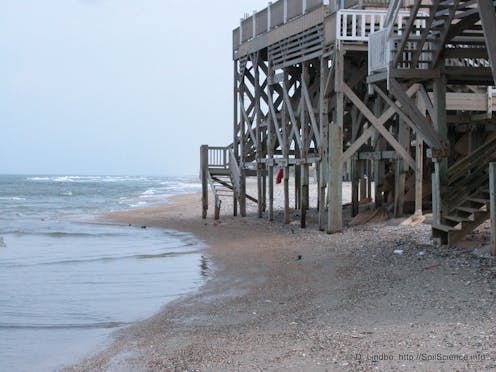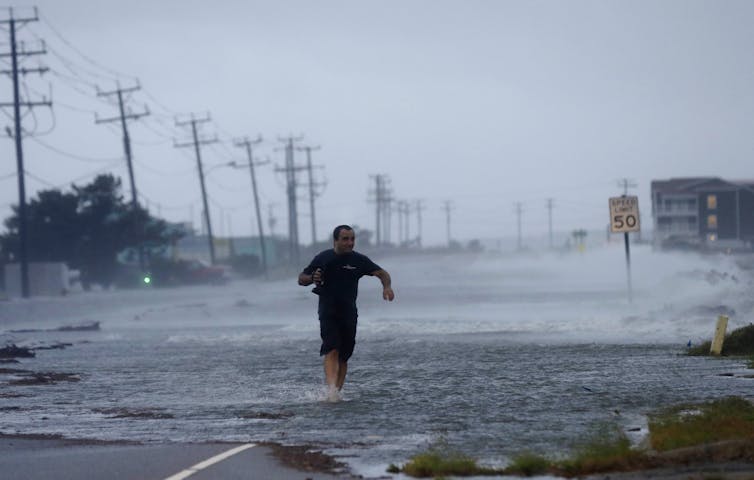Far-sighted adaptation to rising seas is blocked by just fixing eroded beaches
Many US coastal towns are building defenses to protect against rising seas and storms. This can encourage people to stay in place when they should be moving inland.

Coastal communities around the world are struggling to adapt to rising sea levels and increasingly severe coastal storms. In the United States, local governments are making investments to reduce those risks, such as protecting shorelines with seawalls, “nourishing” eroded beaches by adding sand and rerouting or redesigning roads and bridges.
In the short run, spending public money this way is economically rational. But in the long run, many people who live near coastlines will probably have to relocate as seas continue to rise.
We have studied this problem by combining insights from our work in economics, coastal geomorphology and engineering. As we have explained elsewhere, short-term actions to adapt to coastal flooding can actually increase risks to lives and property. By raising the value of coastal properties, these steps encourage people to stay in place and delay decisions about more drastic solutions, such as moving inland.
Keeping millions in harm’s way
According to recent estimates, a 1-foot increase in sea levels will put about 1 million people in the United States at risk, and 3 feet will threaten about 4 million people. Global sea levels currently are projected to rise 0.5 to 2.1 feet by 2050 and 1.0 to 8.2 feet by 2100.
As we see it, market forces and public risk reduction policies interact in unexpected ways, reducing incentives for communities to make long-term plans for retreating from the shore. Nourishing beaches and building seawalls signal to individuals and businesses that their risks are lower. This makes them more likely to build long-lasting structures in risky areas and renovate and maintain existing structures. As a result, their property values increase, which reinforces economic and political arguments for more risk-reduction engineering.

To illustrate this pattern, we compared a sample of houses in Nags Head and Kitty Hawk, North Carolina, two popular beach towns less than 10 miles apart on North Carolina’s Outer Banks. When we consulted county tax appraisal values, Nags Head beaches had routinely received sand from beach nourishment, whereas Kitty Hawk beaches had not. On average, homes in our Nags Head sample were worth over US$1 million, while homes in the Kitty Hawk sample were worth about $200,000.
Other researchers have found that in some locations, the threat of rising seas is eroding coastal property values. But this tends to be true for properties that are viewed as highly vulnerable – for example, homes that have already flooded. In contrast, homes that are elevated or have other flood-proofing features tend to have much higher values, so they are perceived as assets.
Subsidizing risky choices
Some amount of risk reduction makes sense. If people who benefited paid its full cost, and everyone involved understood how imminent the risk was and how much engineering solutions would cost, then market forces would likely produce reasonably efficient solutions.
As an example, flood-prone Norfolk, Virginia recently adopted an ordinance requiring almost all new homes and many major renovations to be elevated and include other flood-proofing features. This approach will help to price flood protection into the cost of homes and will tend to reduce demands to directly subsidize protective engineering, flood insurance and post-disaster assistance.
In our view, such solutions are a move in the right direction. But they will not break the positive feedback loop we describe as long as other public policies continue to skew perceptions of the long-term viability of coastal communities.
Engineering projects to slow shoreline retreat and reduce flooding generally receive smaller subsidies now than in past decades, but many communities still benefit. For example, beach nourishment in Ocean City, Maryland is cost-shared between the federal government, which pays about half, and state and local agencies. The Federal Emergency Management Agency helps pay to rebuild homes and public buildings damaged in major disasters. And allowing people to deduct local taxes on their federal tax forms partly subsidizes local tax financing for risk reduction.
Inaccurate perceptions of risk
Information and uncertainty are larger problems. Many coastal residents do not perceive medium- and long-term climate risk to be as serious as the scientific consensus suggests. Moreover, scientists are still analyzing how fast sea levels are likely to rise. Future storm frequency is uncertain, and could be affected by changes in global greenhouse gas emission trends.
On the positive side, engineering innovations such as designing storm-resistant homes could become more effective. But existing approaches like beach nourishment are likely to become more expensive as sand resources diminish and more communities compete for them. And growing uncertainty is likely to increase near-term demand for risk reduction engineering.
The most critical time for adaptation decisions is immediately after a storm or flood. Faced with expensive repairs or rebuilding, property owners face higher costs to return to the status quo. But if homeowners expect that public resources will be spent to protect them against future disasters, they are less likely to consider making big changes.
Federal or state financial rebuilding assistance creates a similar bias. If that money were used to subsidize relocation or other drastic adaptive actions, rebuilding patterns would be different. So far, however, programs for buying out flood-damaged properties have been largely unsuccessful. Many factors, including residents’ level of experience with disaster recovery and financial concerns, can make people unwilling to consider relocating.
Incentives to think long-term
There is no perfect formula for balancing near-term climate-proofing against more drastic steps to move people away from the coasts. But we believe that when communities focus excessively on reducing near-term threats, they risk inhibiting the successful adaptation that they are trying to promote.
We have three suggestions for breaking this cycle. First, local land use policies could be designed to discourage rebuilding homes to similar or higher property values after damage from storms. Second, communities could put increasing emphasis on adaptive engineering and large-scale planning practices – for example, sunsetting beach nourishment projects when sea level rise reaches some preannounced level.
Finally, adaptation decisions could be planned and implemented at a multi-jurisdictional level, rather than town by town. This approach would help to avoid “rich towns get richer” dynamics that can develop when wealthier jurisdictions deploy sand resources and other protective measures in a way that reduces their own risk while ignoring or heightening threats to nearby locations.
Change is coming to coasts around the world. We believe that broader understanding of how markets and public policy interact is essential to minimize the social and economic costs of this change.
Andrew G Keeler receives funding from the National Science Foundation.
Dylan McNamara has received funding from the National Science Foundation, the Gordon and Betty Moore Foundation, the National Oceanic and Atmospheric Administration, and the North Carolina Sea Grant.
Jennifer Irish receives or has received funding from the National Science Foundation, National Oceanic and Atmospheric Administration’s Sea Grant, U.S. Army Corps of Engineers, U.S. Department of Energy, U.S. Nuclear Regulatory Commission, National Commission on Energy Policy, South Atlantic Landscape Conservation Cooperative, State of Texas Department of Public Safety, and Texas General Land Office. She is a Diplomate of Coastal Engineering and licensed Professional Engineer in New York and in Virginia. She is or has recently been affiliated with the American Society of Civil Engineers, American Geophysical Union, American Shore and Beach Preservation Association, PIANC, and Engineers Without Borders.
Read These Next
West Antarctica’s history of rapid melting foretells sudden shifts in continent’s ‘catastrophic’ geo
A picture of what West Antarctica looked like when its ice sheet melted in the past can offer insight…
As millions of Americans face a steep rise in health insurance costs, lawmakers continue a century-l
US health care policy will remain fractured until lawmakers address the core question of who is responsible…
Understanding climate change in America: Skepticism, dogmatism and personal experience
Real skeptics study the evidence and ask questions, rather than taking political dogma on faith. Experiencing…






